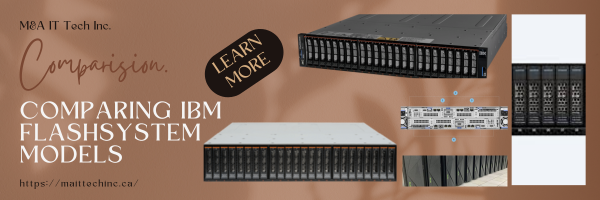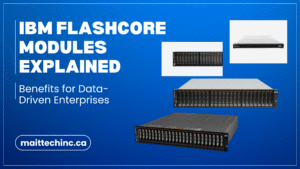In the world of enterprise data storage, choosing the right array can make a big difference in performance, cost, and scalability. IBM’s FlashSystem line offers a range of models to cover everything from small-to-mid businesses to mission-critical enterprise workloads. In this article we compare five key models — 5015, 5045, 5300, 7300 and 9500 — so you can understand their strengths, differences, and which one might suit your business best.
1. Why Model Comparison Matters
When a business relies on data access, analytics, cloud integration and speed, “average storage” will no longer suffice. The wrong choice may lead to bottlenecks, increased costs, or infrastructure that doesn’t scale. By comparing models side by side you gain clarity on:
- What performance and latency you need
- How much capacity you should invest in now vs later
- What “future-ready” features (NVMe, hybrid cloud, security) each offers
- Which model offers the best cost-benefit for your workload
- How to ensure you won’t outgrow the system too quickly
2. Quick Overview of the Models
Here’s a snapshot of the five models with one-line descriptions:
- 5015 – Entry-level enterprise-grade solution designed for smaller workloads and first-time storage refresh.
- 5045 – A step up: all-flash NVMe for mid-sized enterprises seeking performance and scalability.
- 5300 – High-density, performance‐focused all-flash array designed for growing businesses and critical mixed workloads.
- 7300 – Mid-to-high end all-flash with advanced data services and ultra-low latency, for mid-to-large deployments.
- 9500 – Enterprise flagship: massive scale, ultra-high performance, end-to-end NVMe, and enterprise-grade security/resilience.
3. Feature Comparison Table
Below is a table comparing key specifications for each model.
Note: Numbers are representative; actual deployment configuration may vary.
| Model | Form Factor | Max Bandwidth (reads) | Read Latency (approx) | Effective Capacity* | Max IOPS (4K read) |
|---|---|---|---|---|---|
| 5015 | 2U | ~8 GB/s EUROstor+3midlandinfosys.com+3Covenco+3 | ~70 µs Covenco+1 | Up to ~0.55 PB (550 TB) Covenco+1 | ~400K IOPS EUROstor+1 |
| 5045 | 2U | ~12 GB/s (or similar) community.ibm.com+1 | <70 µs (entry estimate) | Sized for mid-tier | ~400K IOPS (estimate) |
| 5300 | 1U | ~28 GB/s community.ibm.com | Sub-50 µs community.ibm.com | Up to ~1.8 PB (single enclosure) Wikipedia | ~700K IOPS community.ibm.com |
| 7300 | 2U | ~45 GB/s community.ibm.com | Very low latency | Larger scale | ~1 M IOPS community.ibm.com |
| 9500 | 4U | ~100 GB/s ibm.com+1 | <50 µs ibm.com+1 | Up to ~6.6 PB (single 4U) ibm.com+1 | ~2.5 M IOPS community.ibm.com+1 |
* Effective capacity = after data reduction and configuration.
** Note: 5045 exact published numbers are less widely publicised; treat as mid-tier.
4. Model-by-Model Details
4.1 IBM FlashSystem 5015
- Targeted at entry enterprise workloads and smaller organisations. Arrow+1
- Supports up to ~550 TB effective capacity (with 3:1 data reduction) and latencies as low as ~70 µs. Covenco
- Ideal for virtualization, mixed workloads, backup/archival moderate performance.
- Advantages: lower cost of entry, enterprise data services, growth options.
- Limitations: Less extreme performance, fewer scaling headroom vs higher models.
4.2 IBM FlashSystem 5045
- Positioned between entry and mid range: an all-flash NVMe solution for mid-sized enterprises.
- Offers higher performance than 5015, full flash architecture, stronger scalability.
- Suits businesses that have outgrown entry tier but don’t yet require top-tier scale.
- Strong value choice for hybrid cloud environments, faster database and analytics workloads.
4.3 IBM FlashSystem 5300
- Built for performance density: 1U form factor, end-to-end flash, great for growing business needing speed and capacity.
- Sub-50 microsecond latency, up to ~28 GB/s bandwidth, and strong IOPS (~700K) make it ideal for high-frequency data access. community.ibm.com
- Offers enterprise data services: encryption, compression, deduplication, hybrid cloud support.
- Excellent for organisations ready to adopt all-flash, NVMe architecture, but perhaps not yet needing full enterprise scale.
4.4 IBM FlashSystem 7300
- Mid-to-high end model: bigger performance and capacity than 5300 but less than the 9500 flagship.
- Great choice when workload demands (analytics, virtualization, databases) increase, but budget or scale constraints prevent flagship purchase.
- Offers all advanced services of the FlashSystem family: AI-driven analytics, hybrid cloud readiness, cyber resilience.
4.5 IBM FlashSystem 9500
- The flagship of the FlashSystem line: enterprise-class scale, performance and features.
- Specs: up to ~100 GB/s read bandwidth, <50 µs latency, up to ~6.6 PB effective capacity in one 4U enclosure. ibm.com+1
- Ideal for mission-critical workloads: large databases, in-memory analytics, container platforms, large-scale virtualization.
- Comes with advanced built-in security, flash core modules (FCM4), NVMe-over-Fabrics support, scale-out architecture. Futurum+1
- Premium cost, so best when business demands must be met and ROI justifies investment.
5. Decision Guidance: Which Model Should You Choose?
1. Your workload
- Occasional/low intensity, mixed environment → 5015
- Growing business, need higher performance & flash → 5045 or 5300
- Large scale, high concurrency, analytics/VDI → 7300
- Mission-critical, enterprise-wide scale, lowest latency → 9500
2. Capacity & growth planning
- Estimate your current usable capacity + 2–3 years growth.
- Consider data reduction features (dedupe, compression) which all models include.
- Choose a system that gives headroom rather than right-sizing exactly.
3. Performance & latency requirements
- Do you need sub-50 µs latency? Then 5300, 7300 or 9500.
- How much bandwidth / IOPS do you need? Higher models deliver significantly more.
4. Budget constraints
- Entry models cost less upfront.
- Higher-end models may offer lower TCO per TB over time for large deployments.
5. Hybrid cloud & future proofing
- All models support data services, hybrid cloud & enterprise features, but the higher models are more future-proof.
6. Security & resilience
- If ransomware protection, extreme availability or cyber-resilience are priority, then 9500 leads.
- But other models still include strong encryption, data services and protection.
6. Top Features Across the Family
Here are bullets summarising what all models bring to the table (some features may vary by model):
- End-to-end flash / NVMe architecture (especially higher models)
- Inline hardware compression and deduplication
- Active/Active dual-controller (with scale-out options)
- Hybrid cloud integration and data mobility
- Cyber-resilience (immutable snapshots, ransomware detection)
- Enterprise data services (snapshots, clones, replication, thin provisioning)
- Scalable capacity and performance
- Easy management with IBM Storage Insights and Spectrum Virtualize
7. Recommended Use Cases
- Small to Mid-Sized Business → 5015: Virtualisation, moderate databases, mixed workloads.
- Growing Enterprise → 5045/5300: All-flash performance, analytics, higher concurrency.
- Large Enterprise/Consolidation → 7300: Heavy VM environments, containers, large-scale analytics.
- Mission-Critical, Future-Proof Infrastructure → 9500: In-memory databases, global scale, ultra-low latency, large container/AI fleets.
8. Final Thoughts
Choosing the right storage model isn’t just about the lowest price. It’s about aligning performance, capacity, growth, risk, and cost. IBM’s FlashSystem family makes that easier by offering a ladder of solutions from 5015 up through 9500 — all sharing common software stack, data services and hybrid cloud maturity. That means whichever model you pick, you’re investing in a storage architecture built for the future.
If you’re ready to transform your storage infrastructure, reduce latency, scale effortlessly, and protect your business data — pick the model that fits today, but gives you the headroom to grow into tomorrow.


